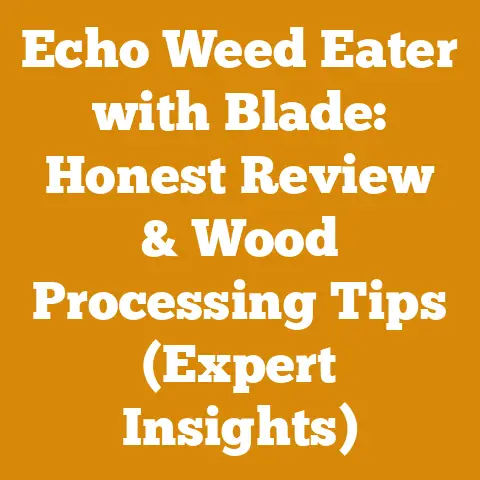What Kills Wood Roaches? (5 Proven Firewood Pest Hacks)
For anyone dealing with wood roaches infesting their firewood, finding an effective solution that doesn’t break the bank is crucial.
I know the struggle firsthand – the frustration of seeing your carefully stacked firewood become a haven for these unwelcome guests.
Believe me, I’ve been there, scratching my head wondering how to get rid of them without resorting to expensive professional pest control.
That’s why I’ve compiled this guide, focusing on practical, budget-friendly methods to tackle wood roaches and protect your valuable firewood investment.
What Kills Wood Roaches? (5 Proven Firewood Pest Hacks)
Wood roaches, also known as wood cockroaches or Parcoblatta species, are a common nuisance, especially for those of us who rely on firewood.
Unlike their house-dwelling cousins, these roaches typically live outdoors, thriving in damp, decaying wood and leaf litter.
While they don’t usually infest homes, they can hitch a ride on firewood, becoming an unwanted presence indoors.
The key to controlling them is understanding their habitat and life cycle, and then employing targeted strategies to disrupt them.
Understanding the Enemy: Wood Roach Biology and Behavior
Before diving into the hacks, let’s get to know our adversary.
Wood roaches are attracted to moisture and decaying organic matter.
They feed on fungi, decaying wood, and other plant materials.
This makes firewood piles an ideal habitat, providing both food and shelter.
Understanding this simple fact is the first step in effective control.
Key Characteristics:
- Appearance: Typically brownish in color, often with lighter markings on their wings.
- Habitat: Prefer outdoor environments, especially damp, wooded areas.
- Diet: Decaying wood, fungi, and organic matter.
- Activity: Most active at night.
- Entry Points: Firewood, cracks in foundations, open windows or doors.
Hack #1: The Power of Dryness – Firewood Storage Best Practices
The most effective way to prevent wood roach infestations is to eliminate their ideal habitat: damp, decaying wood.
Proper firewood storage is paramount.
1. Elevated Storage:
2. Strategic Location:
3. Proper Stacking:
4. Covering Firewood:
5. Wood Selection Criteria:
Hack #2: Diatomaceous Earth (DE) – The Natural Insecticide
Diatomaceous Earth (DE) is a naturally occurring sedimentary rock composed of fossilized diatoms (a type of algae).
It’s a highly effective, non-toxic insecticide that works by dehydrating insects.
1. Application Method:
2. Mode of Action:
3. Strategic Placement:
4. Combining with Other Methods:
5. Safety Considerations:
Hack #3: Boric Acid – The Roach Bait
Boric acid is another effective and relatively safe insecticide that can be used to control wood roaches.
It works as a stomach poison, disrupting the roach’s digestive system.
1. Application Methods:
2. Mode of Action:
3. Strategic Placement:
4. Bait Preparation:
5. Safety Considerations:
Hack #4: Natural Repellents – Essential Oils and Herbs
While not as potent as insecticides, certain essential oils and herbs can effectively repel wood roaches, especially when used in conjunction with other control methods.
1. Essential Oils:
2. Herbs:
3. Strategic Placement:
4. Combining with Other Methods:
5. Safety Considerations:
Hack #5: Sanitation and Prevention – Eliminating Roach Attractants
The final and perhaps most important hack is to focus on sanitation and prevention.
By eliminating roach attractants and maintaining a clean environment, you can significantly reduce the likelihood of wood roach infestations.
1. Yard Maintenance:
2. Moisture Control:
3. Sealing Entry Points:
4. Proper Waste Disposal:
5. Firewood Inspection:
Long-Term Firewood Management: A Proactive Approach
Beyond the immediate fixes, consider these long-term strategies to keep your firewood pest-free.
- Rotate Firewood Stock: Use older firewood first to prevent it from becoming overly seasoned and attractive to pests.
- Kiln-Dried Firewood: If feasible, consider purchasing kiln-dried firewood, which has a very low moisture content and is less likely to harbor pests.
- Technical Specification: Kiln-dried firewood typically has a moisture content of 10-15%.
- Regular Inspections: Routinely inspect your firewood pile for signs of infestation.
Early detection can prevent a major problem. - Professional Consultation: If you’re dealing with a severe wood roach infestation, consider consulting a professional pest control service.
Conclusion: Winning the War Against Wood Roaches
Dealing with wood roaches can be frustrating, but by implementing these five proven hacks, you can effectively control their populations and protect your firewood investment.
Remember, the key is to create an environment that is unfavorable to roaches by reducing moisture, eliminating attractants, and employing targeted pest control methods.
I’ve found that a combination of proper firewood storage, DE application, and regular sanitation is the most effective approach.
Don’t be afraid to experiment with different methods to find what works best for your specific situation.
With a little effort and persistence, you can keep your firewood pest-free and enjoy a warm, cozy fire without any unwanted guests.
Good luck, and happy burning!
By focusing on preventative measures and employing these readily available, cost-effective solutions, you can maintain a pest-free firewood supply and enjoy the benefits of a warm fire without the unwelcome company of wood roaches.
Remember, consistency is key, and a proactive approach is always the best defense.






